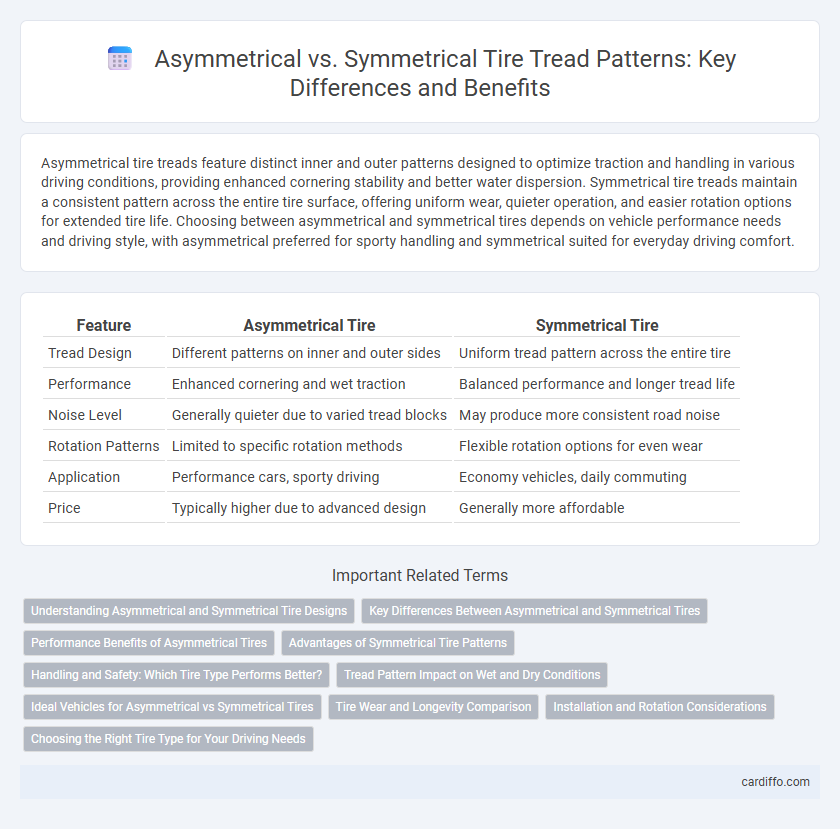Asymmetrical tire treads feature distinct inner and outer patterns designed to optimize traction and handling in various driving conditions, providing enhanced cornering stability and better water dispersion. Symmetrical tire treads maintain a consistent pattern across the entire tire surface, offering uniform wear, quieter operation, and easier rotation options for extended tire life. Choosing between asymmetrical and symmetrical tires depends on vehicle performance needs and driving style, with asymmetrical preferred for sporty handling and symmetrical suited for everyday driving comfort.
Table of Comparison
| Feature | Asymmetrical Tire | Symmetrical Tire |
|---|---|---|
| Tread Design | Different patterns on inner and outer sides | Uniform tread pattern across the entire tire |
| Performance | Enhanced cornering and wet traction | Balanced performance and longer tread life |
| Noise Level | Generally quieter due to varied tread blocks | May produce more consistent road noise |
| Rotation Patterns | Limited to specific rotation methods | Flexible rotation options for even wear |
| Application | Performance cars, sporty driving | Economy vehicles, daily commuting |
| Price | Typically higher due to advanced design | Generally more affordable |
Understanding Asymmetrical and Symmetrical Tire Designs
Asymmetrical tire designs feature varied tread patterns across the tire surface to optimize handling, traction, and water dispersion in specific zones, enhancing performance in both dry and wet conditions. Symmetrical tires have uniform tread patterns across the entire tire, offering consistent wear and lower rolling resistance, making them ideal for everyday driving and longer tread life. Understanding the differences helps drivers select tires tailored to their driving style and vehicle requirements, maximizing safety and efficiency.
Key Differences Between Asymmetrical and Symmetrical Tires
Asymmetrical tires feature distinct tread patterns on the inner and outer sides, optimizing handling and traction on dry and wet surfaces, while symmetrical tires have uniform tread patterns across the entire tire for even wear and quieter performance. Asymmetrical designs enhance cornering stability and grip, making them ideal for high-performance vehicles, whereas symmetrical tires provide longer tread life and simpler rotation patterns suitable for everyday driving. The key differences lie in tread design complexity, performance benefits, and maintenance requirements.
Performance Benefits of Asymmetrical Tires
Asymmetrical tires provide enhanced performance benefits by combining different tread patterns on the inner and outer sections, optimizing grip and handling in varied driving conditions. The outer tread offers increased cornering stability and lateral grip, while the inner tread enhances water evacuation and wet traction, reducing the risk of hydroplaning. This design improves overall vehicle responsiveness, making asymmetrical tires ideal for high-performance and sport driving.
Advantages of Symmetrical Tire Patterns
Symmetrical tire patterns offer consistent tread design across the entire tire, enhancing even wear and extending tire lifespan. These patterns provide balanced handling and a smooth, quiet ride, making them ideal for everyday driving on paved roads. Their versatility allows for easy tire rotation in multiple configurations, promoting uniform performance and safety.
Handling and Safety: Which Tire Type Performs Better?
Asymmetrical tires offer enhanced handling by combining different tread patterns that optimize grip and stability during cornering, making them ideal for high-performance driving. Symmetrical tires provide consistent tread wear and predictable performance, contributing to overall safety and reliability on a variety of road conditions. When prioritizing handling and safety, asymmetrical tires typically perform better due to their design focused on maximizing traction and control.
Tread Pattern Impact on Wet and Dry Conditions
Asymmetrical tire tread patterns provide enhanced traction and handling by combining multiple tread designs on a single tire, optimizing wet grip with inner grooves and dry performance with outer blocks. Symmetrical tread patterns offer uniform tread design that promotes even wear and a quieter ride but can sacrifice some wet traction compared to asymmetrical tires. The impact on wet and dry conditions is significant: asymmetrical tires improve water evacuation to reduce hydroplaning and maintain stability, while symmetrical tires excel in consistent, predictable performance across varied road surfaces.
Ideal Vehicles for Asymmetrical vs Symmetrical Tires
Asymmetrical tires are ideal for high-performance vehicles and sports cars due to their varied tread patterns that optimize grip, handling, and cornering stability. Symmetrical tires suit everyday passenger cars and sedans, offering uniform tread design that enhances smooth ride quality, long tread life, and low rolling resistance. Choosing the right tire type depends on driving style and vehicle type, as asymmetrical tires excel in dynamic driving conditions while symmetrical tires prioritize durability and comfort.
Tire Wear and Longevity Comparison
Asymmetrical tires feature varying tread patterns across their surface, optimizing grip and handling while promoting even wear by adapting to different driving conditions, which can extend tire longevity. Symmetrical tires have uniform tread patterns on both sides, leading to predictable wear but potentially shorter lifespan under aggressive or uneven driving styles. Choosing asymmetrical tires often results in better wear distribution and enhanced durability compared to symmetrical tires, especially for performance and all-season use.
Installation and Rotation Considerations
Asymmetrical tires require specific mounting on the wheel to ensure the tread pattern faces outward, optimizing handling and water dispersion, while symmetrical tires have identical patterns on both sides, allowing flexible mounting options. Rotation patterns for asymmetrical tires often follow a front-to-back or side-to-side approach but must maintain the correct side facing outward, whereas symmetrical tires can be rotated in more varied patterns including cross rotations. Proper installation and rotation of asymmetrical tires are crucial for maximizing tire wear, traction, and overall performance, differentiating them from the more versatile installation and rotation of symmetrical tires.
Choosing the Right Tire Type for Your Driving Needs
Selecting between asymmetrical and symmetrical tires depends on your driving style and vehicle requirements. Asymmetrical tires offer enhanced cornering performance and traction by combining different tread patterns across the tire, making them ideal for sporty driving and variable road conditions. Symmetrical tires provide consistent wear, lower rolling resistance, and a quieter ride, making them suitable for everyday commuting and long-lasting performance.
Asymmetrical vs Symmetrical Infographic

 cardiffo.com
cardiffo.com